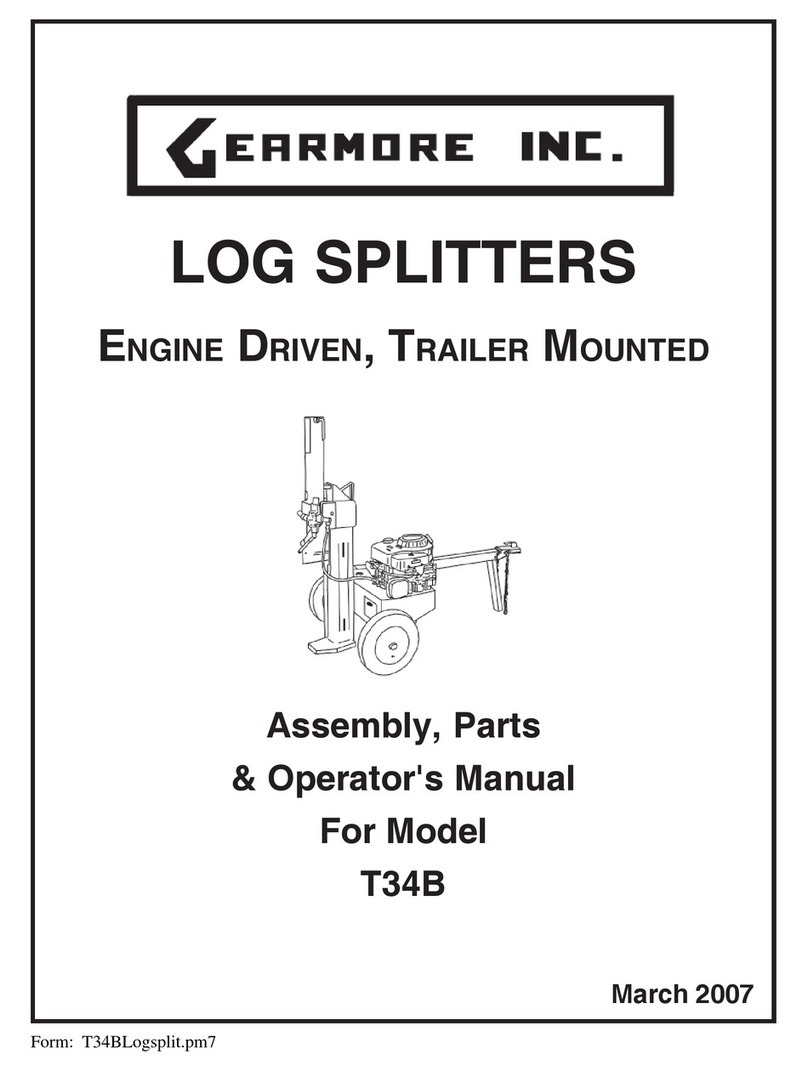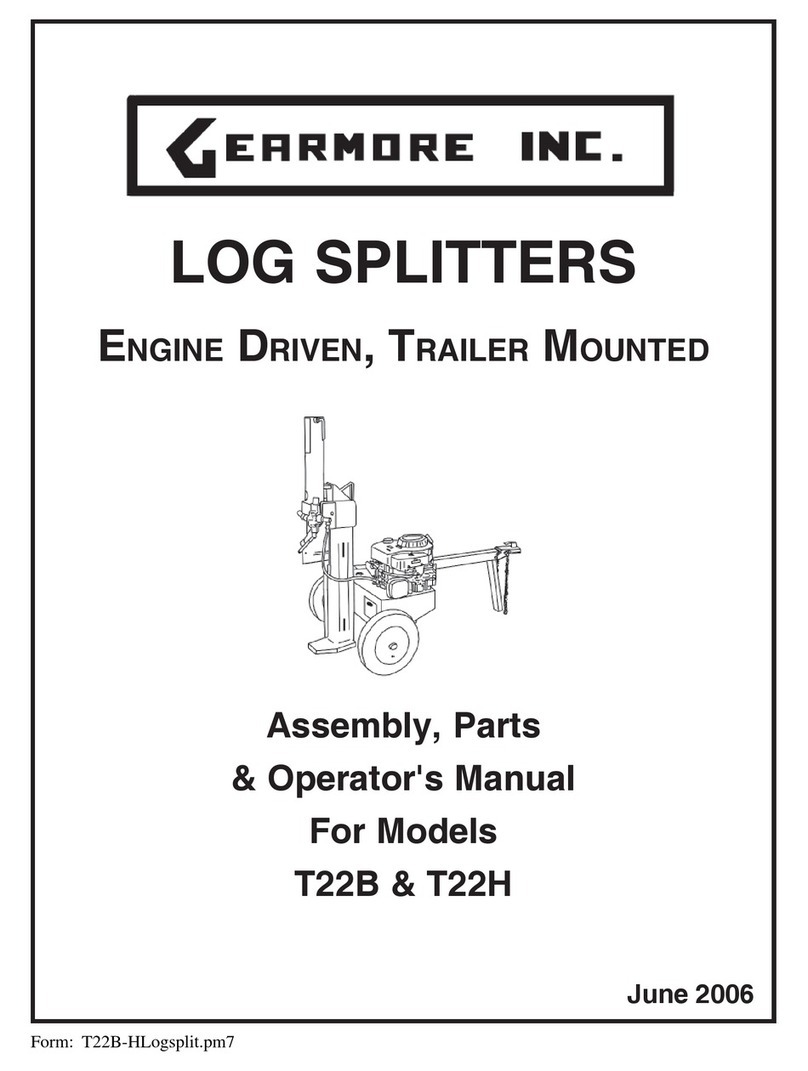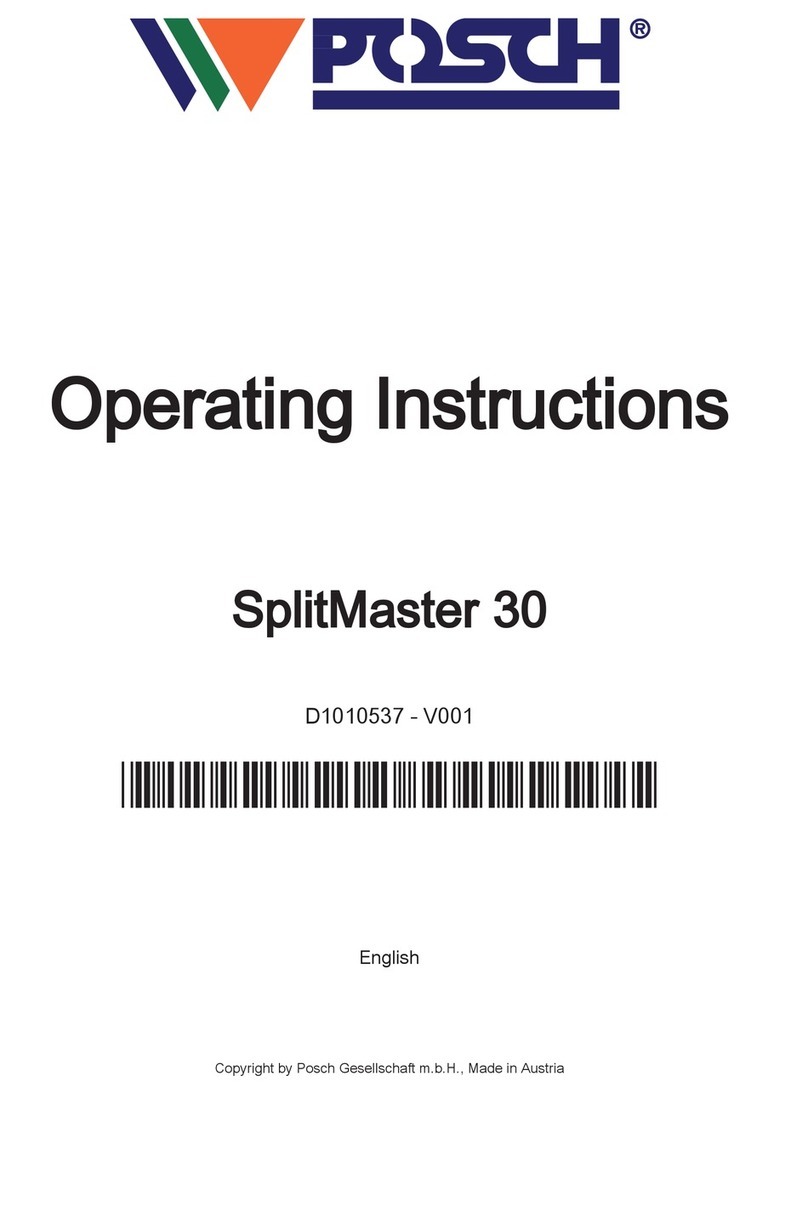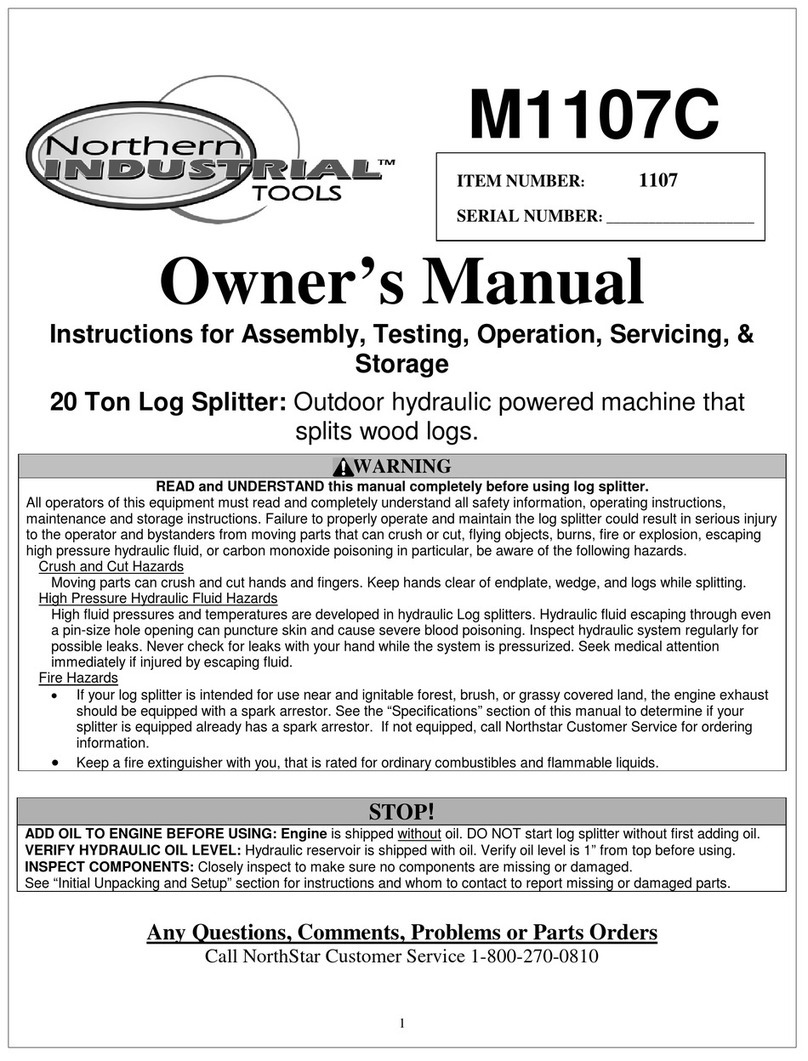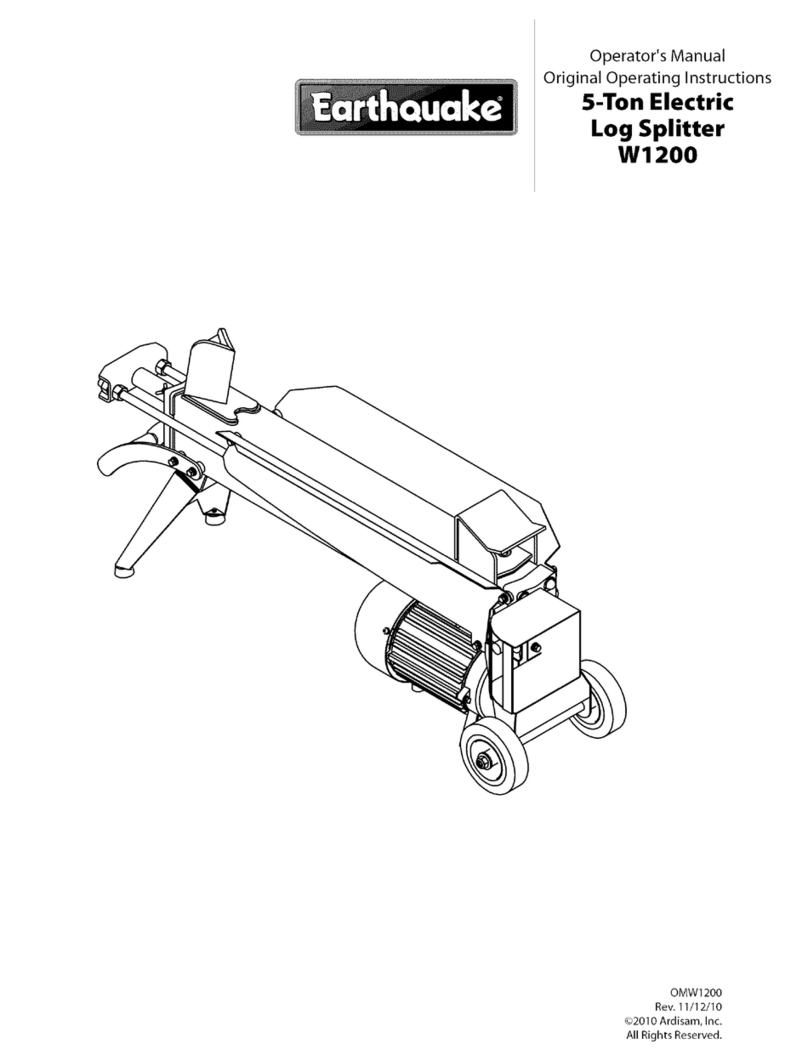Gearmore LS20E User manual

3-POINT LOG
SPLITTER
Assembly, Parts
& Operator's Manual
For Model
LS20E
August 2004
Form: LS20ELogsplit.pm7

1 Introduction............................................................. 1
1.1 Serial Number Location ........................................ 2
2 Safety ....................................................................... 3
2.1 General Safety ...................................................... 4
2.2 Equipment Safety Guidelines ............................... 5
2.3 Safety Training ..................................................... 6
2.4 Safety Signs ......................................................... 6
2.5 Preparation ........................................................... 7
2.6 Hydraulic Safety ................................................... 7
2.7 Operating Safety ................................................... 8
2.8 Transport Safety ................................................... 9
2.9 Storage Safety ...................................................... 9
2.10 Maintenance Safety .............................................. 9
3 Safety Sign Locations .......................................... 10
4 Operation ............................................................... 11
4.1 To the New Operator or Owner ........................... 11
4.2 Machine Components ......................................... 11
4.3 Assembly ............................................................ 12
4.4 Pre-Operation Checklist...................................... 13
4.5 Field Operation .............................................. 14-16
4.6 Vertical to Horizontal Conversion ....................... 17
4.7 Transporting ....................................................... 18
4.8 Storage ............................................................... 18
5 Service and Maintenance ..................................... 19
5.1 Service................................................................ 19
5.1.1 Fluids and Lubricants .................................................. 19
5.1.2 Greasing ...................................................................... 19
5.1.3 Servicing Intervals ....................................................... 19
5.2 Maintenance ....................................................... 20
5.2.1 Changing Seals in Valve ............................................. 20
5.3 Premature Kick-Out ............................................ 21
6 Trouble Shooting .................................................. 22
7 Specifications ....................................................... 23
7.1 Mechanical ......................................................... 23
7.2 Bolt Torque ......................................................... 24
8 Parts Breakdown .................................................. 25
8.1 Log Splitter .................................................... 25-26
8.2 Hydraulic Valve Assembly .................................. 27
8.3 Conversion-Open to Closed Center Valve ...........28
9 Limited Warranty ...................................................29
TABLE OF CONTENTS
SECTION DESCRIPTION
PAGE

1
1 INTRODUCTION
Congratulations on your choice of a 3 Point Hitch Log Splitter to complement your log splitting
operation. This equipment has been designed and manufactured to meet the needs of a discrimi-
nating buyer for the efficient splitting of logs.
The Gearmore 3-point, PTO driven Log Splitter is the latest compact designed splitter. The Log
Splitter can be used in the vertical or horizontal position.
Safe, efficient and trouble free operation of your Log Splitter requires that you and anyone else
who will be operating or maintaining the machine, read and understand the Safety, Operation,
Maintenance and Trouble Shooting information contained within the Operator's Manual.
This manual covers the 3 Point Hitch Log Splitter. Use the Table of Contents as a guide to locate
required information.
Keep this manual handy for frequent reference and to pass on to new operators or owners. Call
your dealer if you need assistance, information or additional copies of the manuals.
OPERATOR ORIENTATION - The directions left, right, front and rear, as mentioned
throughout this manual, are as seen from the driver's seat and facing in the direction of travel.

2
1.1 SERIAL NUMBER LOCATION
Always give your dealer the serial number of your 3 Point Hitch Log Splitter when ordering parts or
requesting service or other information.
The serial number plate is located where indicated. Please mark the number in the space provided for
easy reference.
Model No: _____________________________
Serial No: _____________________________
Date of Purchase: _______________________

2 SAFETY
SAFETY ALERT SYMBOL
Why is SAFETY important to you?
The Safety Alert symbol identifies
important safety messages on the
Gearmore Log Splitter and in the
manual. When you see this symbol,
be alert to the possibility of personal
injury or death. Follow the instruc-
tions in the safety message.
This Safety Alert symbol means
ATTENTION! BECOME ALERT!
YOUR SAFETY IS INVOLVED!
Accidents Disable and Kill
Accidents Cost
Accidents Can Be Avoided
3 Big Reasons
WARNING - Indicates a potentially hazard-
DANGER - Indicates an imminently hazardous
CAUTION - Indicates a potentially hazardous
situation that, if not avoided, may
result in minor or moderate injury.
It may also be used to alert against
unsafe practices.
ous situation that, if not avoided,
could result in death or serious
injury, and includes hazards that are
exposed when guards are removed.
It may also be used to alert against
unsafe practices.
situation that, if not avoided, will
result in death or serious injury.
This signal word is to be limited to
the most extreme situations typi-
cally for machine components
which, for functional purposes,
cannot be guarded.
SIGNAL WORDS:
Note the use of the signal words DANGER,
WARNING and CAUTION with the safety
messages. The appropriate signal word for
each message has been selected using the
following guide-lines:
If you have any questions not answered in this manual or require additional copies or the manual is
damaged, please contact your dealer.
SI NO LEE INGLES, PIDA AYUDA
A AIGUIEN QUE SI LO LEA PARA
QUE LE TRADUZCA LAS
MIDIDAS DE SEGURIDAD.
3

1. Read and understand the
Operator’s Manual and all
safety signs before operating,
maintaining, adjusting or
unplugging the Log Splitter.
4
2.1 GENERAL SAFETY
2. Have a first-aid kit available
for use should the need arise
and know how to use it.
3. Have a fire extinguisher
available for use should the
need arise and know how to
use it.
4. Wear appropriate
protective gear. This
list includes but is not
limited to:
- A hard hat
- Protective shoes
with slip resistant
soles
SAFETY
YOU are responsible for the SAFE operation and
maintenance of your 3 Point Hitch Log Splitter.
YOU must ensure that you and anyone else who is
going to operate, maintain or work around the Log
Splitter be familiar with the operating and mainte-
nance procedures and related SAFETY informa-
tion contained in this manual. This manual will take
you step-by-step through your working day and
alerts you to all good safety practices that should be
adhered to while operating the Log Splitter.
Remember, YOU are the key to safety. Good
safety practices not only protect you but also the
people around you. Make these practices a working
part of your safety program. Be certain that
EVERYONE operating this equipment is familiar
with the recommended operating and maintenance
procedures and follows all the safety precautions.
Most accidents can be prevented. Do not risk injury
or death by ignoring good safety practices.
• Log Splitter owners must give operating
instructions to operators or employees before
allowing them to operate the machine, and at
least annually thereafter per OSHA (Occupa-
tional Safety and Health Administration)
regulation 1928.57.
• The most important safety feature on this
equipment is a SAFE operator. It is the
operator’s responsibility to read and understand
ALL Safety and Operating instructions in the
manual and to follow these. Most accidents can
be avoided.
• A person who has not read and understood all
operating and safety instructions is not qualified
to operate the machine. An untrained operator
exposes himself and bystanders to possible
serious injury or death.
• Do not modify the equipment in any way.
Unauthorized modification may impair the
function and/or safety and could affect the life
of the equipment.
•Think SAFETY! Work SAFELY!
- Protective
goggles, glasses or
face shield
- Heavy gloves
- Protective clothing
5. Install and secure all guards before starting.
6. Do not allow riders.
7. Wear suitable ear protection
for prolonged exposure to
excessive noise.
8. Place all controls in neutral, stop tractor engine,
set park brake, remove ignition key and wait
for all moving parts to stop before servicing,
adjusting, repairing or unplugging.
9. Clear the area of people, especially small
children, before starting.
10. Review safety related items annually with all
personnel who will operating or maintaining
the Log Splitter.

5
2.2 EQUIPMENT SAFETY GUIDELINES
1. Safety of the operator and bystanders is one of
the main concerns in designing and developing
a machine. However, every year many acci-
dents occur which could have been avoided by
a few seconds of thought and a more careful
approach to handling equipment. You, the
operator, can avoid many accidents by
observing the following precautions in this
section. To avoid personal injury or death,
study the following precautions and insist those
working with you, or for you, follow them.
2. In order to provide a better view, certain
photographs or illustrations in this manual may
show an assembly with a safety shield removed.
However, equipment should never be operated
in this condition. Keep all shields in place. If
shield removal becomes necessary for repairs,
replace the shield prior to use.
3. Replace any safety sign or instruction sign that is
not readable or is missing. Location of such
safety signs is indicated in this manual.
4. Never use alcoholic beverages or drugs which
can hinder alertness or coordination while
operating this equipment. Consult your doctor
about operating this machine while taking
prescription medications.
5. Under no circumstances should young
children be allowed to work with this
equipment. Do not allow persons to
operate or assemble this unit until they
have read this manual and have developed
a thorough understanding of the safety
precautions and of how it works. Review
the safety instructions with all users annually.
6. This equipment is dangerous to children and
persons unfamiliar with its operation. The
operator should be a responsible, properly
trained and physically able person familiar with
farm machinery and trained in this equipment's
operations. If the elderly are assisting with
work, their physical limitations need to be
recognized and accommodated.
7. Use a tractor equipped with a Roll Over
Protective Structure (ROPS) and a seat belt.
8. Never exceed the limits of a piece of machin-
ery. If its ability to do a job, or to do so safely,
is in question - DON'T TRY IT.
9. Do not modify the equipment in any way.
Unauthorized modification may result in
serious injury or death and may impair the
function and life of the equipment.
10. In addition to the design and configuration of
this implement, including Safety Signs and
Safety Equipment, hazard control and accident
prevention are dependent upon the awareness,
concern, prudence, and proper training of
personnel involved in the operation, transport,
maintenance, and storage of the machine.
Refer also to Safety Messages and operation
instruction in each of the appropriate sections
of the Tractor and machine Manuals. Pay close
attention to the Safety Signs affixed to the
Tractor and the machine.

2.3 SAFETY TRAINING
1. Safety is a primary concern in the design and
manufacture of our products. Unfortunately,
our efforts to provide safe equipment can be
wiped out by a single careless act of an
operator or bystander.
2. In addition to the design and configuration of
equipment, hazard control and accident
prevention are dependent upon the aware-
ness, concern, prudence and proper training
of personnel involved in the operation, trans-
port, maintenance and storage of this equip-
ment.
3. It has been said, "The best
safety feature is an in-
formed, careful operator."
We ask you to be that kind
of an operator. It is the
operator's responsibility to read and under-
stand ALL Safety and Operating instructions
in the manual and to follow these. Accidents
can be avoided.
4. Working with unfamiliar equipment
can lead to careless injuries. Read this
manual, and the manual for your
tractor, before assembly or operating,
to acquaint yourself with the machines.
If this machine is used by any person
other than yourself, or is loaned or
rented, it is the machine owner's re-
sponsibility to make certain that the
operator, prior to operating:
a. Reads and understands the
operator's manuals.
b. Is instructed in safe and proper use.
5. Know your controls and how to stop tractor
engine, and machine quickly in an emer-
gency. Read this manual and the one pro-
vided with your tractor.
6. Train all new personnel and review instruc-
tions frequently with existing workers. Be
certain only a properly trained and physically
able person will operate the machinery. A
person who has not read and understood all
operating and safety instructions is not
qualified to operate the machine. An
untrained operator exposes himself and
bystanders to possible serious injury or
death. If the elderly are assisting with farm
work, their physical limitations need to be
recognized and accommodated.
2.4 SAFETY SIGNS
1. Keep safety signs clean and legible at all
times.
2. Replace safety signs that are missing or have
become illegible.
3. Replaced parts that displayed a safety sign
should also display the current sign.
4. Safety signs are available from your author-
ized Distributor or Dealer Parts Department
or the factory.
How to Install Safety Signs:
• Be sure that the installation area is clean and
dry.
• Be sure temperature is above 50°F (10°C).
• Determine exact position before you remove
the backing paper. (See Section 3).
• Remove the smallest portion of the split
backing paper.
• Align the sign over the specified area and
carefully press the small portion with the
exposed sticky backing in place.
• Slowly peel back the remaining paper and
carefully smooth the remaining portion of the
sign in place.
• Small air pockets can be pierced with a pin
and smoothed out using the piece of sign
backing paper.
6

7
2.5 PREPARATION
1. Never operate the tractor and machine until
you have read and completely understand
this manual, the Tractor Operator's Manual,
and each of the Safety Messages found on the
safety signs on the tractor and machine.
2. Personal
protection
equipment
including hard
hat, safety
glasses, safety
shoes, and
gloves are
recommended
during assem-
bly, installation, operation, adjustment,
maintaining, repairing, removal, or moving
the implement. Do not allow long hair, loose
fitting clothing or jewelry to be around
equipment.
3. PROLONGED EXPOSURE
TO LOUD NOISE MAY
CAUSE PERMANENT
HEARING LOSS!
Tractors with or without
equipment attached can often
be noisy enough to cause
permanent, partial hearing
loss. We recommend that you wear hearing
protection on a full-time basis if the noise in
the Operator's position exceeds 80db. Noise
over 85db on a long-term basis can cause
severe hearing loss. Noise over 90db adjacent
to the Operator over a long-term basis may
cause permanent, total hearing loss. NOTE:
Hearing loss from loud noise (from tractors,
chain saws, radios, and other such sources
close to the ear) is cumulative over a lifetime
without hope of natural recovery.
4. Operate the machine only with a tractor
equipped with an approved
Roll-Over-Protective
Structure (ROPS). Always
wear your seat belt. Serious
injury or even death could
result from falling off the
tractor ---particularly during
a turnover when the
operator could be pinned under the ROPS or
the tractor.
2.6 HYDRAULIC SAFETY
1. Make sure that all the components in the
hydraulic system are kept in good condition
and are clean.
2. Replace any worn, cut, abraded, flattened or
crimped hoses and metal lines.
3. Stop engine or motor, disconnect spark plug
wire or unplug power cord, and wait for all
moving parts to stop before servicing, adjust-
ing, repairing or cleaning.
4. Do not attempt any makeshift repairs to the
hydraulic lines, fittings or hoses by using
tapes, clamps or cements. The hydraulic
system operates under extremely high-
pressure. Such repairs will fail suddenly and
create a hazardous and unsafe condition.
5. Wear proper hand and
eye protection when
searching for a high-
pressure hydraulic leak.
Use a piece of wood or
cardboard as a backstop
instead of hands to
isolate and identify a
leak.
6. If injured by a concentrated high-pressure
stream of hydraulic fluid, seek medical
attention immediately. Serious infection or
toxic reaction can develop from hydraulic
fluid piercing the skin surface.
7. Before applying pressure to the system, make
sure all components are tight and that lines,
hoses and couplings are not damaged.
• Think SAFETY! Work SAFELY!
5. Clear working area of stones, branches or
hidden obstacles that might be hooked or
snagged, causing injury or damage.
6. Operate only in daylight or good artificial
light.
7. Be sure machine is properly mounted, ad-
justed and in good operating condition.
8. Ensure that all safety shielding and safety
signs are properly installed and in good
condition.

8
2.7 OPERATING SAFETY
1. Please remember it is important that you
read and heed the safety signs on the Log
Splitter. Clean or replace all safety signs if
they cannot be clearly read and understood.
They are there for your safety, as well as the
safety of others. The safe use of this machine
is strictly up to you, the operator.
2. All things with moving parts are potentially
hazardous. There is no substitute for a
cautious, safe-minded operator who recog-
nizes potential hazards and follows reason-
able safety practices. The manufacturer has
designed this Log Splitter to be used with all
its safety equipment properly attached, to
minimize the chance of accidents. Study this
manual to make sure you have all safety
equipment attached.
3. If a safety shield or guard is removed for any
reason, it must be replaced before the ma-
chine is again operated.
4. Personal protection equipment including
hard hat, safety glasses, hearing protection,
safety shoes, and tight gloves are
recommended during assembly, installation,
operation, adjustment, maintaining,
repairing, removal, or moving. Do not allow
long hair, loose fitting clothing, or jewelry to
be around moving parts.
5. Always use two people to handle heavy,
unwieldy components during assembly,
installation, removal or moving.
6. Never place any part of your body, fingers,
hands, feet, etc. where it would be in danger
if movement should occur during assembly,
installation, operation, maintaining,
repairing, removal or moving. Keep others
away.
7. Do not allow bystanders within 20 feet of
machine during operation. Wood chips can
fly out and injure others.
8. Do not step over or straddle splitter during
operation.
9. Do not try to split more than one log at a
time. The extra log can fly out and cause
injury.
10. Keep your fingers and hands away from
cracks in the log that can open while
splitting.
11. Always load logs by holding on the sides, not
the top and bottom.
12. Do not load the splitter when the wedge is in
motion.
13. Do not try to split logs across the grain.
Some kinds can burst or splinter and fly out
of machine causing injury.
14. For uneven cut logs, always place the wide
end down and the most square kind against
the splitting wedge.
15. Never use alcoholic beverages or drugs which
can hinder alertness or coordination while
operating this equipment. Consult your
doctor about operating this machine while
taking prescription medications.
16. Do not allow riders on the machine or tractor
at any time. There is no safe place for any
riders.
17. Before you operate the machine, check over
all pins, bolts, connections and hydraulic
components to be sure all are securely in
place and tight. Tighten or replace any
leaking, damaged or worn parts immediately.
18. Do not allow anyone who is not familiar with
the safety rules and operation instructions to
use this machine.
19. Never allow children to operate or be around
this machine.
20. Use stabilizer bars, adjustable sway chains,
or sway blocks on the tractor lift arms to
keep the machine from swinging side to side.
Adjust as tightly as practical for best per-
formance.
21. Do not operate on slopes or hillsides. Sloping
terrain can cause logs to roll or slip.
22. Clear the work area of objects which might
be picked up and snagged or entangled in the
machine. Do not operate on slippery, wet,
muddy or icy surfaces. Good footing prevents
slipping and tripping.

- Keep service
area clean and
dry.
- Be sure electrical
outlets and tools
are properly
grounded.
- Use adequate
light for the job at
hand.
3. Make sure there is plenty of ventilation.
Never operate the engine of the towing
vehicle in a closed building. The exhaust
fumes may cause asphyxiation.
4. Before working on this machine, shut off the
engine, set the brakes, and remove the
ignition keys.
6. Never work under equipment unless it is
blocked securely.
7. Use personal protection devices such as eye,
hand and hearing protectors, when perform-
ing any service or maintenance work.
8. Where replacement parts are necessary for
periodic maintenance and servicing, genuine
factory replacement parts must be used to
restore your equipment to original specifica-
tions. The manufacturer will not be respon-
sible for injuries or damages caused by use of
unapproved parts and/or accessories.
9. A fire extinguisher
and first aid kit
should be kept
readily accessible
while performing
maintenance on this
equipment.
10. Periodically tighten all bolts, nuts and screws
and check that all cotter pins are properly
installed to ensure unit is in a safe condition.
11. When completing a maintenance or service
function, make sure all safety shields and
devices are installed before placing unit in
service.
2.8 TRANSPORT SAFETY
9
1. Comply with state and local laws governing
highway safety and movement of machinery on
public roads.
2. The use of flashing amber lights is acceptable in
most localities. However, some localities
prohibit their use. Local laws should be
checked for all highway lighting and marking
requirements.
3. At all times, when driving the tractor and
equipment on the road or highway under 20
mph (32 kph) use flashing amber warning
lights and a slow moving vehicle (SMV)
identification emblem. Do not exceed 20 mph
(32 kph). Reduce speed on rough roads and
surfaces.
4. Plan your route to avoid heavy traffic.
5. Always install transport locks, pins or brackets
before transporting.
6. Do not drink and drive.
7. Be a safe and courteous driver. Always yield to
oncoming traffic in all situations, including
narrow bridges, intersections, etc. Watch for
traffic when operating near or crossing
roadways.
8. Turn into curves or go up or down hills only at
a low speed and at a gradual steering angle.
Make certain that at least 20% of the tractor's
weight is on the front wheels to maintain safe
steerage. Slow down on rough or uneven
surfaces.
9. A heavy load can cause instability of the
tractor. Use extreme care during travel. Slow
down on turns and watch out for bumps. The
tractor may need front counterweights to
counterbalance the weight of the machine.
10. Never allow riders on either tractor or machine.
2.10 MAINTENANCE SAFETY
1. Good maintenance is your responsibility.
Poor maintenance is an invitation to trouble.
2. Follow good shop practices.
2.9 STORAGE SAFETY
1. Store the unit in an area away from human
activity.
2. Do not permit children to play on or around the
stored machine.
3. Store the unit in a dry, level area. Support the
frame with planks if required.

10
REMEMBER - If safety signs have been damaged, removed, become illegible or parts replaced without
signs, new signs must be applied. New signs are available from your authorized dealer.
3 SAFETY SIGN LOCATIONS
The types of safety signs and locations on the equipment are shown in the illustration below. Good safety
requires that you familiarize yourself with the various safety signs, the type of warning and the area, or
particular function related to that area, that requires your SAFETY AWARENESS.
A
B
Part No. DL51-1-57
Location: Top,forwardsectionofhydraulic
cylinder
ALWAYS REPLACE
MISSING OR
DAMAGED DECALS
1. Read and understand Operator’s Manual
thoroughly before operation. Failure to do
so may result in serious injury.
2. Keep all shields in place.
3. Keep hands, feet and clothing away from
power driven parts.
4. Always wear safety glasses and
safety shoes during operation.
5. Always operate out-of-doors with good
ventilation.
6. Always stop engine and remove spark
plug wire before performing maintenance
operations.
7. Always shut off engine when leaving log
splitter unattended, even for a short
period of time.
8. Only one person should load and
operate the log splitter. Keep all others
clear during operation. Never allow one
person to operate valve while another is
positioning the log.
9. Always position log with hands on the
sides of log. Keep hands clear of ends.
10. Keep all children away from the log
splitter.
11. Do not step over the log splitter.
12. Only use hands to operate thecontrol
valve.
13. Do not operate the log splitter while
under the influence of alcohol, drugs or
medication.
14. Always operate the log splitteron level,
dry, non-slippery surfaces. Keep off
slopes.
15. Keep work area clear of split wood,
debris or other obstacles.
16. Always stay in the operator zone when
using the log splitter.
17. Always split wood in the direction of the
grain only.
18. Do not add gasoline while theengine is
hot or running. Allow all spilled gas to
evaporate before using log splitter.
WARNING
Part No. DL51-1-32
Location: Topofhydrauliccylinder
B
A

OPERATING SAFETY
1. Read and understand the Operator’s Manual
and all safety signs before operating, servic-
ing, adjusting, repairing or unplugging.
2. Do not allow riders.
3. Install and secure all guards and shields
before starting or operating.
4. Keep hands, feet, hair and clothing away
from moving parts.
5. Place all controls in neutral, stop tractor
engine, set park brake, remove ignition key
and wait for all moving parts to stop before
servicing, adjusting, repairing or unplugging.
6. Place all tractor and machine controls in
neutral before starting.
7. Always wear the appropriate personal
safety equipment when operating splitter
including but not limited to hard hat, safety
shoes, face shield and heavy gloves.
8. Clear the area of bystanders, especially
small children, before starting.
9. Do not operate on slopes or sidehills.
10. Keep working area clean, neat and dry to
prevent slipping and tripping.
11. Keep all mechanical and hydraulic compo-
nents in good condition. Do not operate
with leaks or damaged components.
12. Load splitter by holding logs on the side
rather than the top and bottom.
13. Do not split wood across the grain.
14. Review safety instructions with all operators
annually.
4.1 TO THE NEW OPERATOR
OR OWNER
The 3 Point Hitch Log Splitter is designed to split
any kind of wood or log. Be familiar with the
machine before starting.
It is the responsibility of the owner or
operator to read this manual and to train
all other operators before they start
working with the machine. Follow all
safety instructions exactly. Safety is
everyone's business. By following recom-
mended procedures, a safe working envi-
ronment is provided for the operator,
bystanders and the area around the
worksite. Untrained operators are not
qualified to operate the machine.
Many features incorporated into this machine are
the result of suggestions made by customers like
you. Read this manual carefully to learn how to
operate the machine safely and how to set it to
provide maximum field efficiency. By following
the operating instructions in conjunction with a
good maintenance program, your Log Splitter
will provide many years of trouble-free service.
4 OPERATION
11
4.2 MACHINE COMPONENTS
The 3 Point Hitch Log Splitter consists of a
wedge on the end of a hydraulic cylinder for
splitting wood or logs. Hydraulic power from the
tractor is routed through a double acting valve to
control the cylinder position. The wedge is
designed with a stripper to remove stuck logs as
the wedge is retracted. The Splitter can be used
in vertical or horizontal configuration.

12
4.3 ASSEMBLY
The machine is shipped from the factory in a
partially disassembled form that allows for easy
and convenient shipping. Refer to the drawing
and parts list should it become necessary to
disassemble the unit for repair or replacement of
parts.
When preparing for the customer, follow this
procedure:
Step 1: After you have cleared the area of
bystanders, especially small children, remove all
components from the crate. Inspect each piece for
shipping damage. If any part is damaged, contact
your dealer or delivering carrier. Use two men to
guide or direct and handle the heavy and bulky
components. Use a crane, hoist or forklift of
sufficient capacity and stability to handle the
components.
Step 2: Attach the four legs to the A-frame
stand using the 5/16" NC x 1 1/2" hex cap screws,
5/16" lockwashers, and 5/16" hex nuts. Tighten.
Step 3: Insert the draw pins into the lower holes
on the A-frame stand. Secure with 7/8"
lockwashers and 7/8" hex nuts. Tighten.
Step 4: Stand the beam on end. Check to see
that it is stable. Line up the bracket holes on the
A-frame stand with the two ears on the beam and
insert the pivot pin. Secure with clip pin.
Step 5: Insert the stub pin through the hole on
the A-frame stand from underneath. Secure with
7/8" lockwasher and 7/8" hex nut.
Step 6: Carefully lower the beam to the
horizontal position. Be certain that the ground
stand is securely in place. Put the lynch pin
through the hole in the stub pin to hold the beam
in place.
Step 7: Attach the hydraulic fittings provided in
the hardware kit to the valve.
Step 8: Back the tractor into position and slide
the lift arms over the draw pins on the A-frame/
stand and secure with a top link pin and a lynch
pin (not provided).
Step 9: IMPORTANT - The tractor must be
able to handle Cat. I or II 3-point hitch
implements and be equipped with a four-way
valve (for double acting cylinders) and hydraulic
outlets.
The tractor owner's manual should be consulted
for instructions on tractor operation, safety, and
auxiliary hydraulic systems pumping and return
flow hookups.
Determine the easiest position to lock the
tractor's valve lever in the operating position.
Then locate the pressure and return ports with
the valve locked in this position. Connect the
hoses from the tractor to the Log Splitter with
the flow from the pressure port entering on the
"IN" side of the valve. The return flow to the
tractor should come from the "OUT" side. (Note:
Ports are 1/2" NPT)
After connecting the hoses to the valve, the
system should be energized by moving the tractor
auxiliary valve in the direction to cause oil flow.
Tie in place. Oil should flow in only one direction
through the hydraulic valve. If the tractor
auxiliary valve is moved to the wrong position,
the Log Splitter relief valve will not operate and
damage to the tractor system or Log Splitter
could result.
The tractor hydraulic system should be capable of
delivering 6 to 25 GPM of oil at 1500 to 2500 PSI
for adequate splitting force and speed. The tractor
should have a cooling system to allow semi-
continous operation.
NOTE: Specifications of the hoses and fittings
supplied by the owner should be within
recommended ranges of the tractor operating
pressure.
Step 10: Using the tractor 3-point hitch, raise
the Log Splitter to a convenient height and level
with the top link. The Log Splitter may be
operated in either the horizontal or vertical
position.

13
4.4 PRE-OPERATION CHECKLIST
Although there are no operational restrictions on
the Log Splitter when used for the first time, it is
recommended that the following mechanical
items be checked:
A. After Operating For 1 and 5 Hours:
1. Check all nuts, bolts and other fasteners.
Tighten to their specified torque level.
2. Check hydraulic system for leaks.
Tighten all leaking fittings and replace
any leaking components.
3. Then go to the service schedule as defined
in the Maintenance Section.
Efficient and safe operation of the Log Splitter
requires that each operator reads and understands
the operating procedures and all related safety
precautions outlined in this section. A pre-operation
checklist is provided for the operator. It is
important for both the personal safety and main-
taining the good mechanical condition of the Log
Splitter that this checklist is followed.
Before operating the machine and each time thereaf-
ter, the following areas should be checked off:
1. Use only a small Agricultural tractor of less
than 100 horsepower on the machine.
2. Check that the machine is properly attached to
the tractor. Be sure retainers are used on the
mounting pins.
3. Be sure extra weights are mounted on the front
of the tractor if required.
4. Check the wedge and strippers. Be sure they
are not damaged or broken and is not badly
worn. Repair or replace as required.
5. Check for entangled material. Remove this
material.
6. Check for hydraulic leaks, tighten fittings or
replace components to stop leaks.

4.5 FIELD OPERATION
Log Splitters attach to a tractor 3 point hitch and
use the tractor hydraulics to move a wedge
through wood to split it. The splitter can be used
in the vertical or horizontal configuration. How-
ever the operator has the responsibility of being
familiar with all operating and safety procedures
and following them.
Each operator should review this section of the
manual at the start of the season and as often as
required to be familiar with the machine. When
using, follow this procedure:
1. Review and follow the Pre-Operation Check-
list.
2. Attach the tractor to the machine.
a. Position the arms and slide the balls over
the mounting pins. Install the retainers.
b. Attach the top link to the mast. Install
the retainer.
OPERATING SAFETY
1. Read and understand the Operator’s Manual
and all safety signs before operating, servic-
ing, adjusting, repairing or unplugging.
2. Do not allow riders.
3. Install and secure all guards and shields
before starting or operating.
4. Keep hands, feet, hair and clothing away
from moving parts.
5. Place all controls in neutral, stop tractor
engine, set park brake, remove ignition key
and wait for all moving parts to stop before
servicing, adjusting, repairing or unplugging.
6. Place all tractor and machine controls in
neutral before starting.
7. Always wear the appropriate personal safety
equipment when operating splitter including
but not limited to hard hat, safety shoes, face
shield and heavy gloves.
8. Clear the area of bystanders, especially
small children, before starting.
9. Do not operate on slopes or sidehills.
10. Keep working area clean, neat and dry to
prevent slipping and tripping.
11. Keep all mechanical and hydraulic compo-
nents in good condition. Do not operate with
leaks or damaged components.
12. Load splitter by holding logs on the side
rather than the top and bottom.
13. Do not split wood across the grain.
14. Review safety instructions with all operators
annually.
IMPORTANT
Do not use on a tractor of more than 100
horsepower.
c. Always engage the anti-sway
components on each lift arm to keep
the unit from moving from side-to-side
during operation.
d. The frame is designed to attach to a
Category I or II, 3 point hitch. Be sure
to use the appropriate sized mounting
pins and bushings when attaching to
tractor.
3. Attach the Hydraulics:
a. Use a clean cloth or paper towel to clean
the tips on the end of the hoses and the
area around the couplers on the tractor.
14

15
b. Insert the male ends into the
couplers on the tractor. Be sure
they are locked in place.
IMPORTANT
Use the remote circuit of the tractor that
is designed with a detent. The circuit can
then be turned on and stay on while the
splitter is being used.
c. Route the hoses over the hitch and secure
in position with clips, tape or plastic ties.
Provide sufficient slack for raising and
lowering the 3 point hitch.
The tractor can be equipped with either
a closed-center or open-centered
hydraulic system.
NOTE
WARNING
Use extreme care when working
around a high-pressure hydraulic
system. Make sure all connec-
tions are tight and all components
are in good repair. Wear hand
and eye protection when search-
ing for suspected leaks.
4. Before going to the working area review
Section 4.7 Transporting.
5. Drive to the working area and stop in a level
area.
6. Lower into working position, stop engine and
set park brake.
7. Set the Machine:
a. Level the Frame:
Use the screw jack on the right lift arm
to level the frame from side-to-side.
b. Frame Angle:
Use the turnbuckle on the top link to set
the frame angle. Normally the frame
should be set parallel to the ground or
vertical depending on the configuration.
8. Controls:
The splitter is designed with a 3 position
hydraulic valve that controls the flow of oil
through the system.
a. Cylinder Ram Extending for
Splitting:
Move the lever toward the base and hold
it to have the cylinder ram extend to
move the wedge for splitting. This
position is spring-loaded and must be
held for the wedge to move and split.
b. Center Neutral Position:
In the centered neutral position the
hydraulic oil from the tractor is bypassed
and returned to the tractor. The wedge
will not move.
c. Cylinder Ram Retracting for
Resetting:
Move the lever toward the cylinder end
and it will go into detent. While in
detent, the wedge will continue to retract
until it reaches the end of its stroke, goes
over relief and pops out of detent. This
feature allows the operator to remove the
split portions of the log and get a new log
while the wedge retracts.
NOTE
Be sure the splitter relief pressure is set below
the tractor relief pressure or the tractor
hydraulics will pop out of its detent rather than
the splitter.
d. Be sure to select the hydraulic circuit on
the tractor with a detent to provide a
constant flow of oil to the machine.
9. Starting:
a. Move tractor into its working position,
lower the frame to the ground and set
park brake. Be sure the working area is
level, dry and free of obstructions.

b. Place the throttle in its mid-range
position.
c. Place the working hydraulic circuit in
detent.
d. Move the splitting wedge/cylinder to its
fully retracted position.
e. Position log between the wedge and the
base of the frame.
f. Move the hydraulic lever toward the base
and hold it while the wedge moves
through the log.
g. Release the lever when the log splits into
2 pieces or the wedge reaches the base
and the wedge will stop.
h. Move the lever in the fully up retracting
direction into detent and it will retract
fully. When fully retracted, the pressure
will exceed 1200 PSI, the control lever
will pop out of detent and the wedge will
stop moving.
10. Log Placement:
a. Always grasp the log by the sides when
placing in the splitter. This will
minimize the chance of the operator
getting their fingers or arm between the
wedge and the log.
b. Always wear the appropriate safety gear
when working around the machine.
This includes but is not limited to:
• Hard hat for protection to the head.
• Face mask for protection to the face and
eyes from flying chips.
• Heavy gloves for protection from slivers,
chips and pinching.
• Safety shoes with slip resistant soles for
protection to the feet and toes from
dropped logs and pieces of wood. Slip
resistant soles reduce the chance of
slipping.
IMPORTANT
If the parking brakes don't hold the tractor,
chock the wheels front and rear.
11. Log Stripper:
Each machine is designed with a log stripper
located next to the wedge when it is in its
retracted position. The stripper consists of a
stationary bracket on each side of the frame
that will push a log or block of wood off the
wedge as it retracts. Always remove all wood
from wedge before proceeding with the next
split.
12. Operating Hints:
a. Hold the hydraulic lever in the wedge
extend direction until the wedge reaches
the base or the log/wood splits. Move it
into detent in the opposite direction to
retract the wedge. The lever will kick out
of detent when it is fully retracted.
b. In cool or cold operating conditions, the oil
can be so viscous that the detent will not
work in the retract wedge mode. The
system will kick out of detent when the
back pressure exceeds more than 200 psi.
Warm the oil by holding the control lever
over relief for a few minutes. As the oil
circulates, it will warm the system and
the detent will function normally.
c. Always keep the working area neat and
clean to prevent tripping. Pile the split
and unsplit wood in piles close to the
working area. Do not allow pieces to pile
up and clutter the area. A cluttered
working area can lead to tripping and an
accident. Do not take chances with
safety.
d. Do not place the splitter on muddy, icy,
wet or cluttered surfaces. Each can lead
to slipping or tripping and cause acci-
dents.
e. Lubricate the plate under the wedge
slider each time the machine is used to
improve wear and reduce friction and/or
binding.
IMPORTANT - To extend the life of the
hydraulic cylinder, avoid "bottoming out" wedge
plate to the foot piece. To conform with industry
safety recommendations, the wedge stops 2
inches from the end of the stroke.
16

17
4.6 VERTICAL TO HORIZONTAL CONVERSION
The Splitter works well in either the vertical or
horizontal configuration. To convert from
vertical to horizontal configuration, follow this
procedure:
1. Clear the area of bystanders, especially small
children.
2. Be sure to have a couple of men to handle the
heavy components or use a hoist, lift or
forklift with the appropriate capacity to
handle the weight.
3. Set the base on the ground, relieve the
pressure in the hydraulic circuit by moving
the control lever through neutral several
times, set the park brake and stop the
engine.
4. Disconnect the hydraulic lines from the
couplers on the tractor and lay to the side so
they will not be pinched.
5. Disconnect the top link.
6. Disconnect the lift arms from the mounting
pins.
7. Use 2 men and/or an appropriate lift assist to
lay the machine on the ground with the
cylinder down.
8. Remove the bolts from the hitch frame
mounting plate.
9. Turn the hitch frame 180° and re-attach to
the mast. Tighten fasteners to their specified
torque.
Log Splitter quickly converts to the horizontal
position. Just lower the beam on hinge and lock
in place with lynch pin.
WARNING: Tilt slowly!
DO NOT move from vertical
to horizontal position unless
frame legs are securely in
place. Tractor lift arms could
fall resulting in serious
injury.
10. Remove the 2, 3 point hitch mounting pins
and move to their new position at the lower
part of the legs. Tighten fasteners to their
specified torque.
11. Turn the Log Splitter over so the cylinder is
on top.
12. Attach to the Tractor:
a. Slide the lift arms over the mounting
pins and install the retainers.
b. Connect the top link and install the
retainer.
c. Level the frame using the lift arm and
the turnbuckle in the top link.
d. Connect the hydraulics.
• Use a clean cloth or paper towel to
clean the tips on the end of the hoses
and the area around the couplers on the
tractor.
• Insert the male ends into the couplers
on the tractor. Be sure they are locked
in place.
• Route the hoses over the hitch and
secure in position with clips, tape or
plastic ties. Provide sufficient slack for
raising.
WARNING
Use extreme care when working
around a high-pressure hydraulic
system. Make sure all connec-
tions are tight and all components
are in good repair. Wear hand
and eye protection when search-
ing for suspected leaks.

18
4.7 TRANSPORTING
TRANSPORT SAFETY
4.8 STORAGE
1. Make sure you are in compliance with all
local regulations regarding transporting
equipment on public roads and highways.
2. Make sure the SMV (Slow Moving Vehicle)
emblem and all the lights and reflectors that
are required by the local highway and
transport authorities are in place, are clean
and can be seen clearly by all overtaking
and oncoming traffic.
3. Do not allow anyone to ride on the Log
Splitter or tractor during transport.
4. Do not exceed 20 mph (32 kph). Reduce
speed on rough roads and surfaces.
5. Use retainers on the mounting pins when
attaching.
6. Always use hazard flashers on the tractor
when transporting unless prohibited by law.
1. Store the unit in an area away from human
activity.
2. Do not permit children to play on or around
the stored machine.
3. Store the unit in a dry, level area. Support
the frame with planks if required.
STORAGE SAFETY
When transporting the machine, review and
follow these instructions:
1. Be sure all bystanders are clear of the ma-
chine.
2. Be sure that the machine is securely
attached to the tractor and all retainer pins
are installed.
3. Be sure you have installed extra weights on
the front of the tractor if required.
4. Clean the SMV emblem, lights and reflectors
and be sure they are working.
5. Be sure you are in compliance with all
applicable lighting and marking regulations
when transporting. Check with your local
authorities.
6. Be sure your machine can clearly be seen by
overtaking and oncoming traffic.
7. Keep to the right and yield the right-of-way to
allow faster traffic to pass. Drive on the road
shoulder if permitted by law.
8. Do not allow riders.
9. Always use hazard flashers on the tractor
when transporting unless prohibited by law.
After the season's use, the machine should be
thoroughly inspected and prepared for storage.
Repair or replace any worn or damaged compo-
nents to prevent any unnecessary down time at
the start of next season. To insure a long,
trouble free life, this procedure should be followed
when preparing the unit for storage:
1. Clear the area of bystanders, especially small
children.
2. Thoroughly wash the machine using a
pressure washer to remove all dirt, mud,
debris and residue.
3. Inspect the wedge, strippers and wear plates
for damage or entangled material. Repair or
replace damaged parts. Remove all entangled
material.
4. Touch up all paint nicks and scratches to
prevent rusting.
5. Move to storage area.
6. Select an area that is dry, level and free of
debris.
7. Fully retract the cylinder ram.
8. Unhook from tractor.
9. If the machine cannot be placed inside, cover
with a waterproof tarpaulin and tie securely
in place.
10. Store the machine in an area away from
human activity.
11. Do not allow children to play on or around
the stored machine.
Table of contents
Other Gearmore Log Splitter manuals
Popular Log Splitter manuals by other brands

EarthQuake
EarthQuake W1000 Operator's manual & parts list

Iron & Oak
Iron & Oak BLACKHAWK BH 1491 owner's manual

Scheppach
Scheppach Ox 3-1200 Translation from the original instruction manual

Champion
Champion 93020 Owner's manual & operating instructions
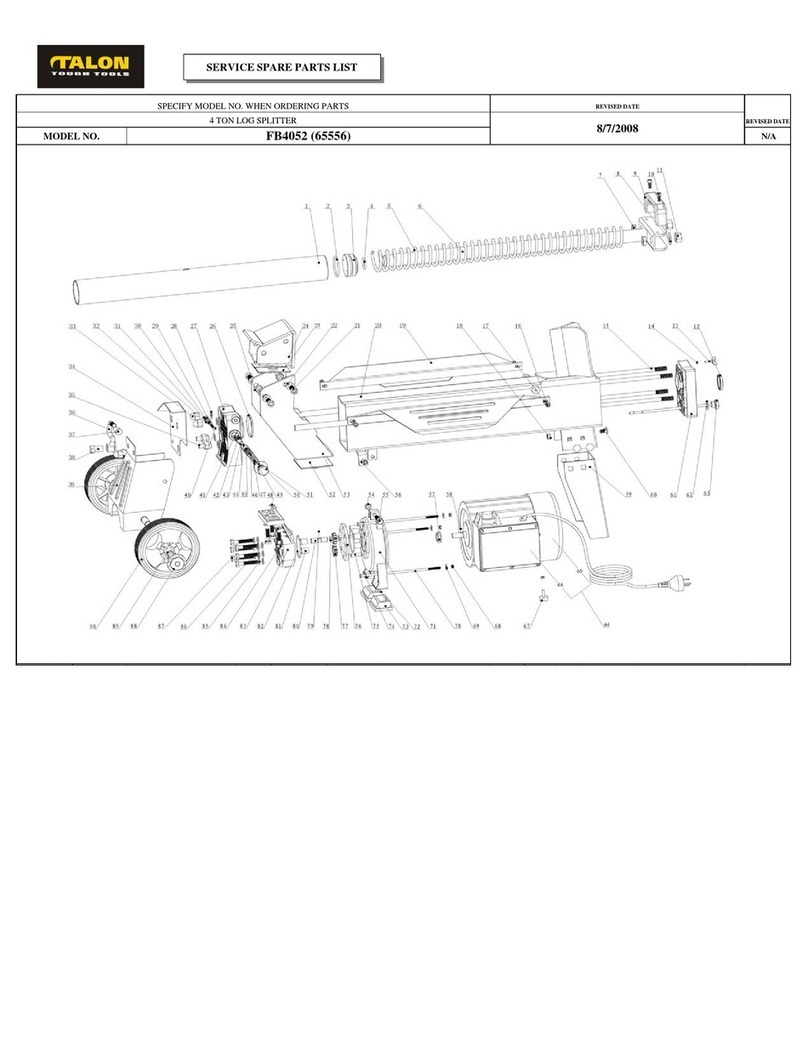
Talon
Talon Talon 65556 parts list

Kingarden
Kingarden LS10TG instruction manual
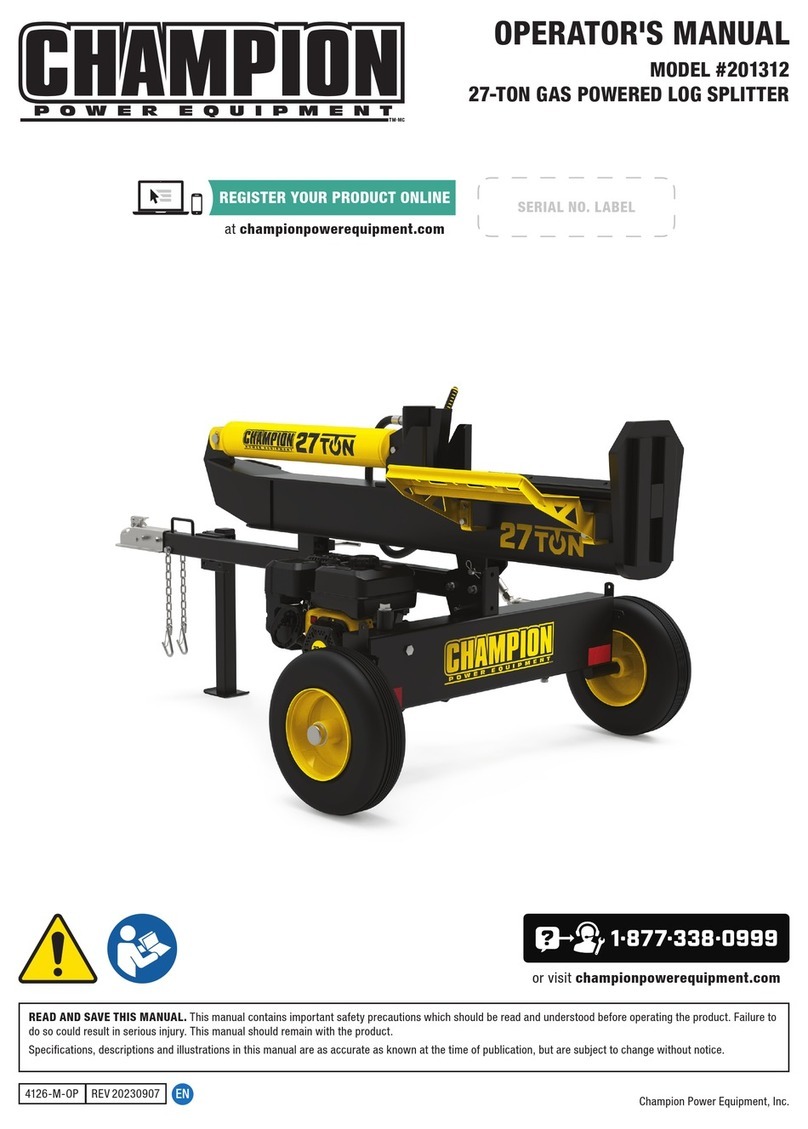
Champion
Champion 201312 Operator's manual
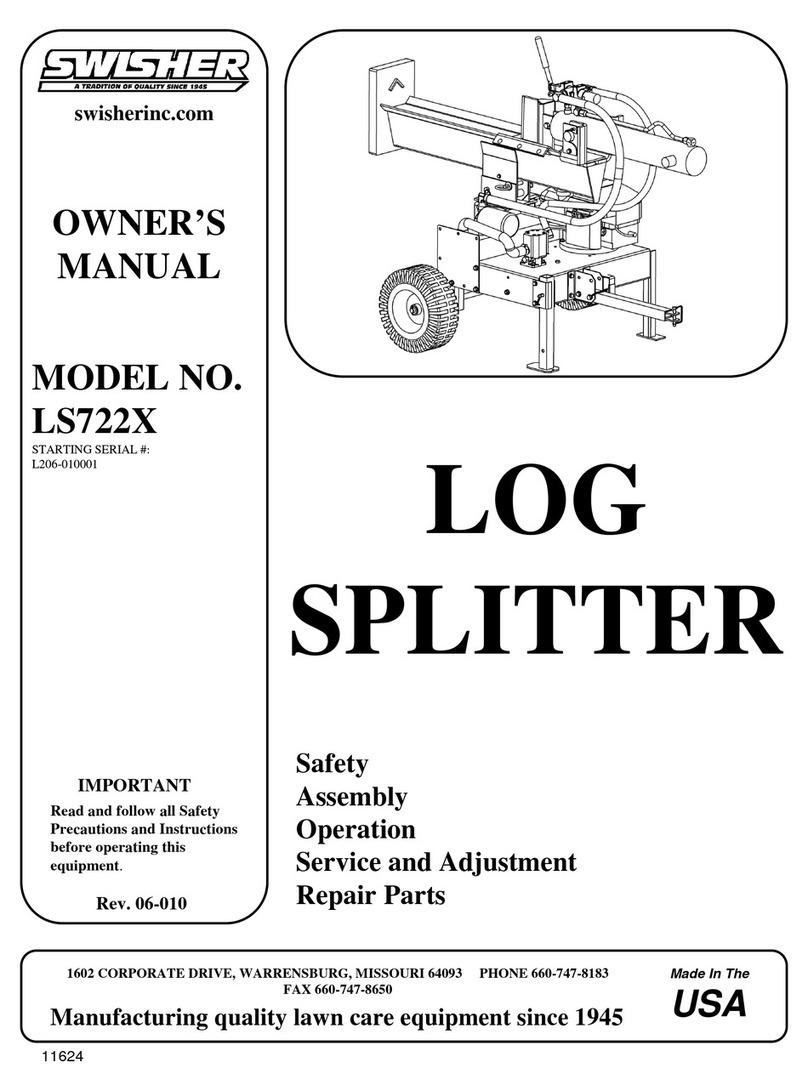
Swisher
Swisher LS722X owner's manual

GÜDE
GÜDE W 520 / 5.5 T UG Original operating instructions
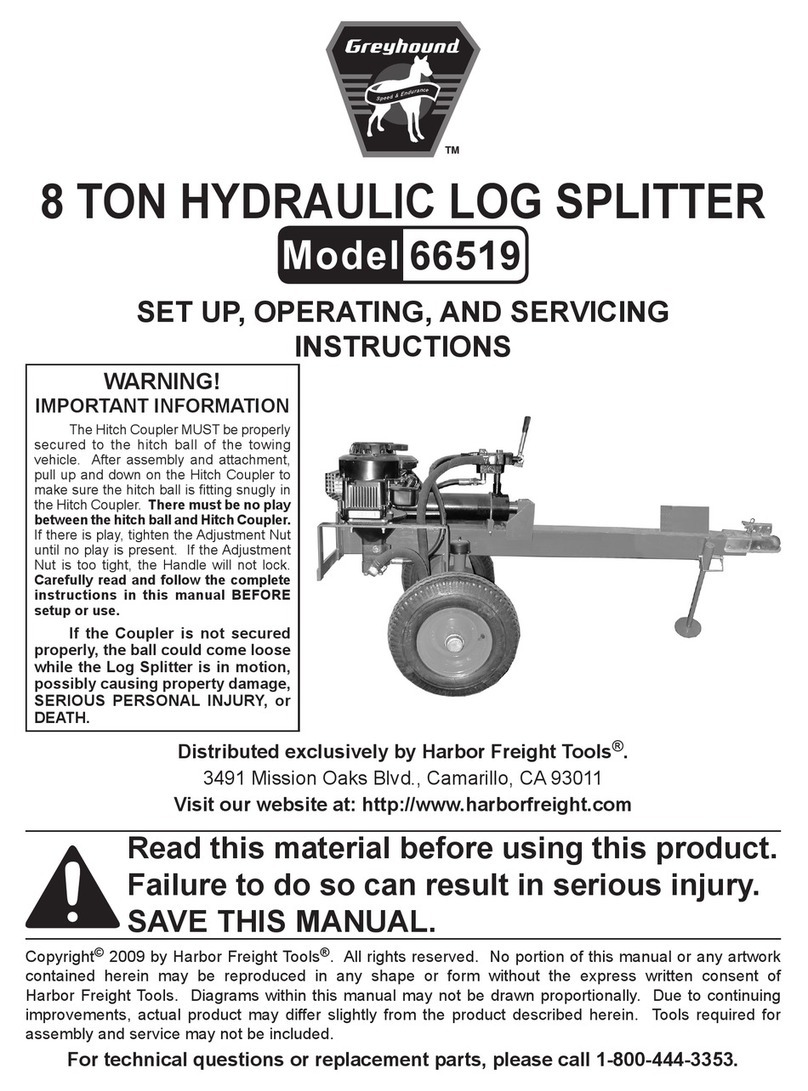
Greyhound
Greyhound 66519 Set up, operating, and servicing instructions
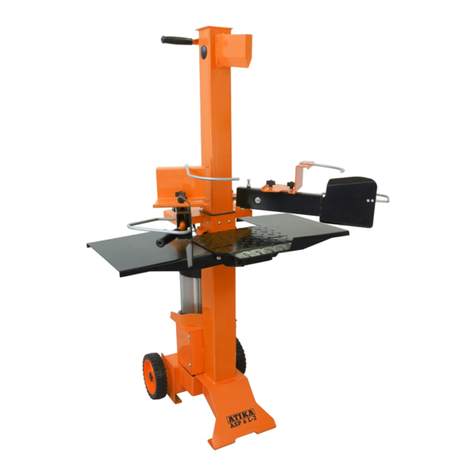
ATIKA
ATIKA ASP 6 L-2 Assembly and operating instruction sheet
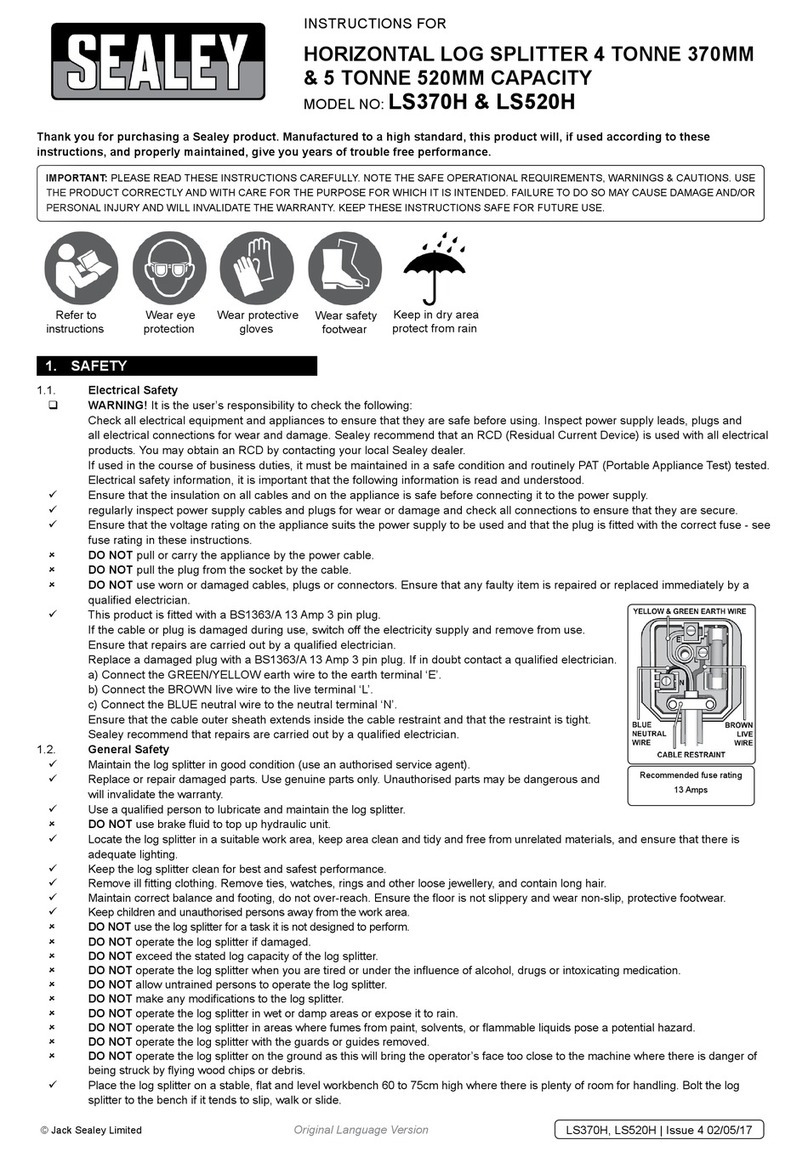
Sealey
Sealey LS370H Instructions for use
